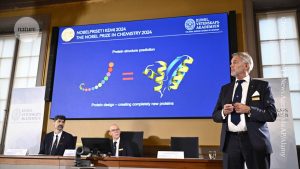
The chemistry award goes to AlphaFoldArtificial intelligence that can predictProtein structures
AlphaFold: Predicting the Structure of Molecular Proteins, Molecules and Drugs from DeepMind-Computational Intelligence
One half of the Nobel Prize in Chemistry has been awarded to computer scientist Demis Hassabis, who co-founded the Google-owned artificial-intelligence company DeepMind, and theoretical chemist John Jumper, a DeepMind director and researcher. They won for leading the development of AlphaFold, an AI tool for predicting protein structures that has swiftly transformed biology. In 2021, DeepMind announced that it had used AlphaFold to predict the structure of nearly every protein made by humans, as well as the entire ‘proteomes’ of 20 other widely studied organisms.
In 2021 DeepMind made AlphaFold2’s underlying code freely available, along with the data needed to train the model. An AlphaFold database, created with the European Molecular Biology Lab’s European Bioinformatics Institute in Hinxton, UK, now holds the structures of almost all the proteins from every organism represented in genetic databases, some 214 million predictions in total. The company has introduced a third iteration of AlphaFold, a program that can model other molecules that interact with drugs.
Many researchers hope that AlphaFold and other AI tools it has inspired will transform medicine, but it is not yet clear how, or indeed whether, AlphaFold will streamline the costly and multi-step process of developing safe new drugs. Scientists laying the groundwork for new vaccines are finding AlphaFold incredibly useful, and in some cases, game-changing. But AlphaFold is a complement to other approaches to mapping and tweaking the structure of viral proteins for use in vaccines.
What do we really know about planetary vital signs? A warning warning from aqualogists and ecologist Yvonne Sadovy
It’s been 20 years since the launch of space-tourism venture Virgin Galactic. Billionaires seem to be popping up to space regularly — for example, entrepreneur Jared Isaacman, who was both spacewalker and bill-payer on a recent private SpaceX mission. But what about the rest of us? Several ultra-high altitude balloon companies plan to take paying passengers on a trip into thin air for a discounted price.
The dried swim bladders that are the basis of the fish maw market are used by many impoverished communities. But overfishing — particularly with gillnets, which indiscriminately capture many types of fish, dolphin and turtle — could ultimately damage the ecosystem and leave people even worse off. Yvonne Sadovy, a specialist in fish and meat, says there are few controls and little knowledge about the value, importance and potential threats of this. The consequence is that fishers are forced to target species they don’t know anything about in terms of the science.
A blunt and damning report on the state of the climate crisis concludes that “much of the very fabric of life on Earth is imperilled”. A selection of 35 planetary vital signs, such as greenhouse gas emissions and Antarctic ice loss, tell the tale: 25 of them have reached record levels this year. Most records were broken last year. “It is staggering that, in a world where billions of people are already suffering from the impacts of climate change, fossil fuel emissions and deforestation rates are not slowing, but they are actually increasing,” says ecologist and co-author Thomas Crowther.
Elephants have Wrinkles, but don’t know how to take care of them (the Conversation: AlphaFold developers share Nobel Prize in Chemistry)
An elephant would be nothing without its trunk. Researchers have shown that its trunk wouldn’t be complete without it. Wrinkles appear as soon as the trunk develops during gestation — around 20 days in — and concentrate around a pivot point that allows the appendage to wrap around objects. Elephants also develop more wrinkles on one side of their trunks as they grow, depending on whether they’re ‘right-trunked’ or ‘left-trunked’.
Rwanda is experiencing one of the biggest outbreaks of the Marburg virus ever documented. Scientists expect this outbreak to be contained, but warn that Marburg is on the rise, with no proven treatment. Outbreaks of the virus, a ‘cousin’ of the Ebola virus, usually start after a person encounters an infected fruit bat. Researchers say that environmental threats, such as climate change and deforestation, have made people more likely to encounter animals that can pass on infections. Emergency-medicine physician Adam Levine says that the world has to be ready for that.
The winners of the chemistry prize were in attendance. Elephants have trunks that have wrinkled and there is a report about the climate crisis.
The founder of the company behind Replika was inspired by an episode of a dark TV series, but that doesn’t mean she should be trusted with people’s privacy. (The Conversation | 19 min read)
Source: Daily briefing: AlphaFold developers share Nobel Prize in Chemistry
Observing Curiosity’s Mars Rover with the Camera on the End of a Highly-Obscured Optical Car
Considering that NASA’s Mars rover Curiosity has been on the red planet for over a decade, it’s understandable it’s showing signs of a little wear and tear. After 12 years of exploration, we see one of its six well-worn wheels. Despite the rough terrain of Mars, there is still plenty of life in the old rover. The camera on the end of one of the robot arms was used to take this picture. The image is from NASA/JPL-Caltech/MSSS.

